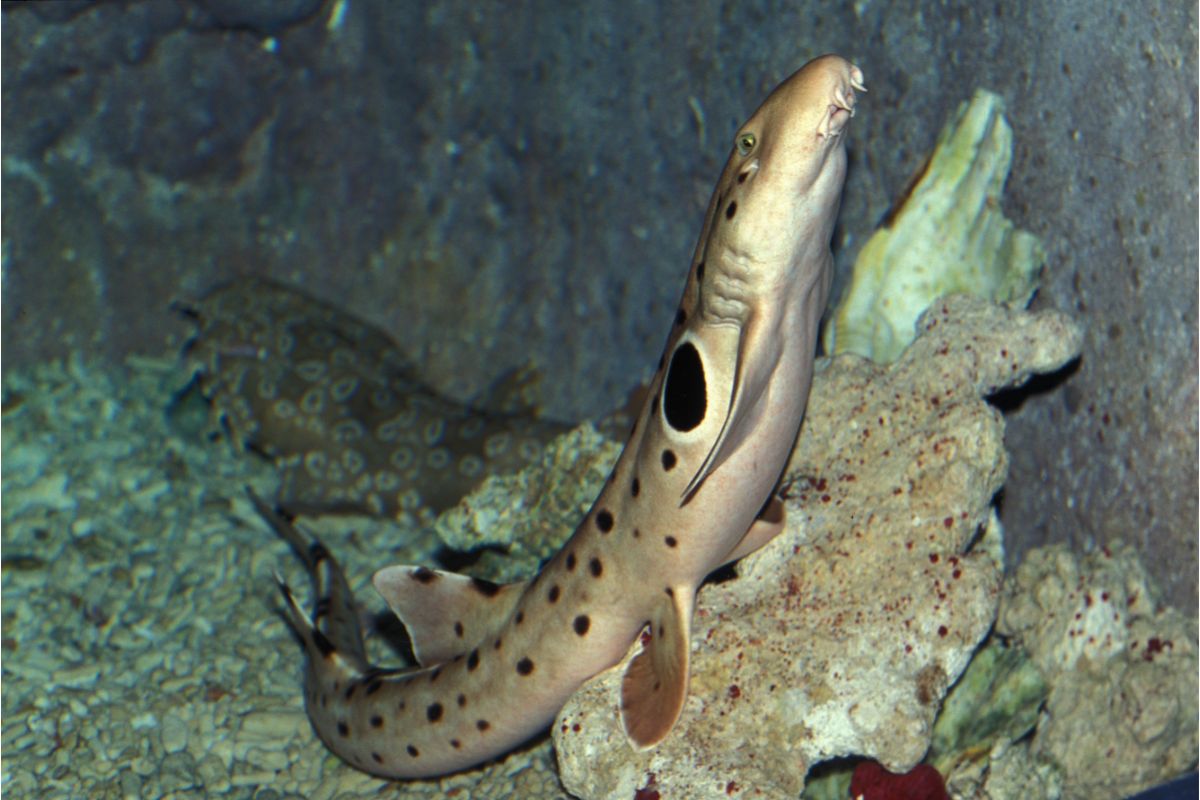What Is An Epaulette Shark?
The Epaulette Shark is a type of fish which is often displayed in aquariums and is often cited as one of the best sharks to use in a fish tank and aquariums.

Because of this a lot of people have questions about this shark, what it is like in the wild, what it is like to keep as a pet, and a litany of other questions about the nature of this shark.
This guide aims to answer all questions for potential owners of this shark as well as those who are just interested. If you have any questions about the Epaulette shark, keep reading!
Background Of The Epaulette Shark
There are 6 specific species of shark which are in the genus of Hemiscyllium which is what Epaulette sharks are in.
These are also all in the species family Hemiscylliidae. In spite of these 6 different species, there is only one which you are likely to see in fish stores and this is Hemiscyllium ocellatum.
This is because the other known species within this family do not occur very often in nature and are therefore not an easy pet choice.
As well as this, all of the locations of these other species make it very difficult to collect fishes too.
Most of the other species in this family are scattered throughout the coast of Papua New Guinea in locations which are very difficult to fish in.
However, most species of Epaulette shark are quite similar in their characteristics, but this article will focus largely on the Hemiscyllium ocellatum as this is the variety which the most is known about and is most common to own.
The Epaulette Shark In Nature
Taxonomy Of The Epaulette Shark
- Kingdom – Animalia
- Phylum – Chordata
- Class – Chondrichthyes
- Order – Orectolobiformes
- Family – Hemiscyllidae
- Genus – Hemiscyllium
- Species – H. ocellatum
- Binomial Nomenclature – Hemiscyllium ocellatum
The first person to speak publicly on this fish was Pierre Joseph Bonnature who was a French naturalist and first described the Epaulette fish as Squalus ocellatus in 1788.
However overtime the name evolved into Hemiscyllium ocellatum which is used today.
The evolutionary development of the genus Hemiscyllium has been tracked to show they are polytomy which implies that there is no resolution between the relationship of the Epaulette shark and any of its sister species in dichotomies.
Description Of The Epaulette Shark
Another way the Epaulette shark is referenced is as the ‘walking shark’ and it is a species of carpet sharks and has a distinct long tail.
This type of shark is most commonly found in tropical shallow waters with the most common locations being the coastal regions of Australia and New Guinea.
Similar to military epaulettes, this species has two black large spots which are surrounded with white marks that are behind its pectoral fins, this is why they have been called Epaulette sharks.
Unlike other types of sharks this species rarely grows to be very big and are generally quite small with it being quite common for Epaulette sharks to be under 39 inches in length at full maturity being less than a full meter.
Because of this manageable size, these sharks are commonly kept in aquariums with them being able to quite easily adapt to the smaller environment with shark keepers therefore not needing to invest in a massive tank like they would for other species.
Since Epaulette sharks have such a slender shape of body, they are able to swim quite comfortable, but as referenced by their other name earlier, they often prefer to actually walk along the bottom of whatever their habitat is by using paired muscle fins which they have.
These are used to push them along as these sharks wriggle throughout reefs which is why they are known as ‘walking sharks’.
When an Epaulette shark is looking for food, it will visit a tidal pool and is able to actually survive out of the water.
Under the Internation Union for Conservation of Nature (ICUN) this species is listed as of the least concern.
They are not recognized much economically by most fishers with most of their value in this market being exclusive to the aquarium market.
Where Can You Find Epaulette Sharks?
As referenced earlier, Epaulette sharks are usually found along the coastal areas of Papua New Guinea (which is in the south of New Guinea), they are also along the northern coastal areas of Australia and even can go as far south as Sydney.
A good amount of Epaulette sharks are in the Capricorn-Bunker group within the Great Barrier Reef and are therefore estimated to have thousands of them living throughout the reefs around the Heron Island.
There are other places where these sharks can be found, most common being the Solomon Islands as well as Sumatra and Malaysia.
However, the claims of Epaulette sharks being found in these locations have not been fully verified.
Why Are Epaulette Sharks In These Areas?
As referenced, these sharks most like to live near reefs and tidal pools, as well as staghorn coral stands, these are all classified as shallow bodies of water.
The maximum depth of water which Epaulette sharks are found in is 50 meters or 160 feet down but are usually only found in water which is only deep enough to cover its body.
The locations which were mentioned in the previous sections are all similar to the conditions mentioned here.
What Are The Physical Characteristics Of An Epaulette Shark?
Body Of An Epaulette Shark
As was referenced, the Epaulette shark has a characteristic slender and long body which more than half of this body being its caudal peduncle.
For the most part, and fully grown Epaulette shark will have a lighter brown or cream base color for its body and feature brown spots which are varying distances apart from each other.
When the species in its more juvenile state it will have darker and lighter bands which will alternate over their body but when they grow, the bands will begin to break up.
And above their pectoral fin they will have two black large characteristic spots which are circles by white to look like false eye spots, these are the characteristics which the Epaulette shark is named after.
Snout Of An Epaulette Shark
An Epaulette shark has a short and distinctively round snout with nares just at the tip and grooves which up to the mouth. There are also nasal barbells which are quite small located at the tip by the nares.
Teeth Of An Epaulette Shark
An Epaulette shark’s upper jaw has a row of anywhere between 26 and 35 teeth with their lower jaw having a more limited 21 to 32.
These teeth are quite small compared to other shared, and they have quite a wide base with triangular cusps.
Eyes Of An Epaulette Shark
Epaulette sharks have oval-shaped eyes which look quite elevated and underneath these eyes is a spiracle which is large.
Gills Of An Epaulette Shark
A standard Epaulette shark will have 5 pairs of slits for its gills. These are relatively small compared to other gilled animals and the 4th and 5th of each pair are close to each other.
Fins Of An Epaulette Shark
Epaulette sharks have pectorals and pelvic fins which possess thick muscles which are what allow them to ‘walk’, they are more broad and rounded.
They have 2 dorsal find on their backs and there is a significant space between the 2 and are similar in their size.
Epaulette sharks also have a caudal fin which just has an upper lobe but does not have a ventral lobe.
The upper lobe has a distinct ventral notch which is close to its tip and this notice is at an angle which is horizontal to the Epaulette shark’s body.
The only other fin and Epaulette shark has is its anal fin which is just ahead of its caudal fin

How Has The Epaulette Shark Adapted To Survive In Its Habitat?
Like all animals, the Epaulette shark has adapted to fit its environment, so let’s look at some of these key adaptions and how they help the Epaulette shark to survive.
How The Epaulette Shark Has Adapted Its Movement
As has been referenced throughout as a distinctive trait of the Epaulette shark is how it has adapted to ‘walking’ across the reefs in its habitat.
This is done by using their muscular pelvic and pectoral fins which are shaped almost like a paddle, and they can be used to push substrates aside as they move.
This pushing movement also resembles wiggling as they move throughout the coral reefs.
These Epaulette sharks are able to swim in deeper water if they need to, however, they definitely have a preference for ‘walking’ along the coral or the sandy shallow waters they tend to live in.
By comparing Epaulette sharks to other shark species we can identify that Epaulette sharks have a unique reduced cartilaginous support for the pair of fins which they commonly use which means that these fins are more like limbs than anything else.
Through their crawling motion they are able to move away from deeper waters and can easily access the tidal pools where they do most of their feeding.
How The Epaulette Shark Has Adapted Its Common Activity?
Most of the Epaulette shark’s common activity takes place in lower water, and they tend to act nocturnally.
For the most part Epaulette sharks hide under or inside coral heads, but this is usually done with just the head similar to an ostrich and leaves the rest of their body exposed.
These sharks have been observed to rest on the sandy flats they prefer and sometimes on top of the reefs and face the water current.
The name for this style of positioning within biology is known as rheotaxis and this can help these sharks with their respiration as well as making them more conscious of any potential predators.
How The Epaulette Shark Has Adapted To Escape Predation
Epaulette sharks tend to be the prey of some larger species of fish including other types of sharks and part of their protection from this is their camouflage through their distinct coloration.
The two aforementioned fake eyes are seen as a deterrent to potential predators.
Epaulette Shark And Parasite Attacks
As well as potential predators, Epaulette sharks are also occasionally victim to parasites with the gnathiid in its praniza (larval stage) being the most common parasite to affect this shark.
Generally speaking, the praniza will attach itself to the cloaca and the claspers of the Epaulette shark, but they can also attach to the mouth and gills in other cases.
These parasites are not always massively harmful to the Epaulette sharks, but they can do some damage like feeding on their blood.
There can be different parasites like Sheina orri which is an ostracod which will attach itself to gills, the Kudoa myxosporean which will attach to the skeleton muscles, Proleptus australis which will go into the stomach and finally the Hemogregarine protozoan which will infect the Epaulette’s blood.
How The Epaulette Shark Has Adapted Its Response To Low Oxygen?
If an Epaulette shark goes into a state of hypoxia in low oxygen conditions its ventilation as well as its heart rate will start to slow immediately.
This will also affect the vessels which carry blood dilates which send blood to the heart and brain, by doing this the blood pressure of the shark will lower as well.
When the Epaulette shark lowers its metabolism rate in its brain, it can deactivate its motor nuclei while managing to keep its sensory nuclei functional.
This will lower the energy demand of the Epaulette shark and will keep enough ATP supple to make sure the neuron remains alive.
In these hypoxic conditions the Epaulette shark will not completely shut down, but it is instead able to remain alert to any danger in its surroundings.
These particular hypoxic conditions are more likely to happen in a shallow reef which is where the Epaulette tend to stay.
This will usually happen at night while the tides are receding and the reef will then become isolated from the ocean which will lower the level of present dissolved oxygen.
This drop has the potential to be quite significant doing up to even 80% and even sometimes above this.
These conditions can remain like this for quite a while, and luckily, the Epaulette shark has the adaptive ability to remain in a hypoxic state for up to several hours and during this time its behavioral responsiveness will not be compromised.
How The Epaulette Shark Has Adapted Its Feeding Habits?
Epaulette sharks are able to track down their prey by using their electro-receptive as well as their olfactory senses. This means that even when their prey is hiding, they will still be able to find them.
An Epaulette shark will eat by sucking the prey into the mouth and will expand its buccal cavity to allow this.
When this species is looking for food it will be able to turn some debris using their snout and will thrust their head into sand to swallow any prey which is under it, and after doing this it can expel the sand out of its gills.
They are able to chew their food for anywhere between 5 and 10 minutes. They also have the ability to depress their teeth to make the inside of their mouth flat and can use this to crush any prey.
Epaulette Shark And Food Materials
Since Epaulette sharks ares essentially bottom feeders, they feed mainly on crustaceans which live on the floor of the sea and are invertebrates.
They can also eat worms and some bony fishes too. They are opportunistic feeders meaning that they are able to eat any time of the day if they have prey.
Specifically the Epaulette sharks which live near Heron Island have adapted to eat mainly annelid worms. Juvenile Epaulette sharks will mainly feed off worms but as they grow older they will prefer crabs instead.
Reproduction Cycle Of The Epaulette Shark
Epaulette sharks are able to mate in the wild between July and December and this is usually done when the male shark follows a female and sometimes bite to initiate the courtship, which will occasionally face some resistance from the female shark.
During procreation the male shark will hold onto the pectoral fin of the female using its mouth and will lie next to the female and insert a clasper into the cloaca of the female for around 2 minutes.
Epaulette sharks are oviparous and will lay eggs between August and December.
During this, the female Epaulette will drop its egg capsules about twice a day for about 2 weeks, but this can sometimes be up to 4 egg capsules a day.
These capsules are around 3.9 inches long and 1.6 inches wide and will take around 120 days to hatch (usually before 130 days).
Once the juvenile Epaulette shark is born it will be between 5.5 and 6.3 inches and will initially grow slowly only picking up the rate of growth at about 3 months.
After 7 years the sharks will get up to 21 to 25 inches and will be considered adults and able to reproduce.
Relationship Between The Epaulette Shark And Humans
If you are at the beach in an area where these sharks reside, there is a good chance you will be able to observe their activities seeing them go in and out of the water.
They do not seem to have any fear of humans and will not harm them, however they may bite people handling them as they can be injured from poor handling skills.
As mentioned in the introduction, they are a good shark choice for aquariums and can adapt well to their captivity and new surroundings. They are often seen in public aquariums in Northern America and Australia.
Aquarium Care For Epaulette Sharks
Epaulette sharks can grow up to 42 inches or 107 cm in length and will require a tank size of 135 gallons or 510 liters or bigger.
They are not a suitable shark to have with other tank mates as they will either threaten their tank mates or be threatened by them.
The best temperature to have their tank is 72 to 82 degree Fahrenheit with a water pH between 8.1 and 8.4 with typical marine saltwater.
Aquarium Size For Epaulette Sharks
While 135 gallons should be enough, when it is at maturity, 180 gallons of water is more appropriate.
Tank Decor For Epaulette Sharks
Make use of aquascaping to give the tank a natural feel. T
hey like hiding in cracks and crevices when in daylight and like using sand for digging into. They will also like plants but do not include unstable reef structures as it could harm the shark.
Tank Mates For Epaulette Sharks
These are not the pet for tank mates and even with others of their species with the only viable option being 2 females as males with agress each other and males with harass females.
If you want a breeding tank make it big enough for them to give each other space.
Lifespan Of An Epaulette Shark
Epaulette sharks like around 20 to 25 years, so this is a good choice if you want a pet that will live for a good amount of time.
Caution With An Epaulette Shark
If you are setting up a breeding colony beware that adults may eat eggs, so you may want to incubate them in a separate tank and make sure to not put them in freshwater.
Takeaway
Hopefully the advice on this page has given you the insight into Epaulette sharks to know what they are like in the wild and like as pets.
If you plan to take care of an Epaulette shark, make sure to follow all the advice in the care section.
Epaulette sharks are very interesting creatures so if you do not want to care for one, being able to see them in person when traveling is also worthwhile.
- Is It Possible For A Shark To Swim Backwards? - August 2, 2024
- Are Leopard Sharks Dangerous? - August 2, 2024
- What Are The Differences Between Shark And Dolphin Fins? - August 1, 2024








